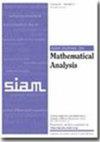Stationary Flows of the ES-BGK Model with the Correct Prandtl Number
IF 1.9
2区 数学
Q1 MATHEMATICS, APPLIED
引用次数: 0
Abstract
SIAM Journal on Mathematical Analysis, Volume 56, Issue 5, Page 6361-6397, October 2024.Abstract. The ellipsoidal BGK model (ES-BGK) is a generalized version of the BGK model where the local Maxwellian in the relaxation operator of the BGK model is extended to an ellipsoidal Gaussian with a parameter [math], so that the correct Prandtl number can be computed in the Navier–Stokes limit. In this work, we consider steady rarefied flows arising from the evaporation and condensation process between two parallel condensed phases, which is formulated in this paper as the existence problem of stationary solutions to the ES-BGK model in a bounded interval with the mixed boundary conditions. One of the key difficulties arises in the uniform control of the temperature tensor from below. In the noncritical case [math], we utilize the property that the temperature tensor is equivalent to the temperature. In the critical case, [math], where such equivalence relation breaks down, we observe that the size of bulk velocity in the [math] direction can be controlled by the discrepancy of boundary flux, which enables one to bound the temperature tensor from below.
具有正确普朗特尔数的 ES-BGK 模型的静态流动
SIAM 数学分析期刊》,第 56 卷第 5 期,第 6361-6397 页,2024 年 10 月。 摘要椭圆BGK模型(ES-BGK)是BGK模型的广义版本,其中BGK模型弛豫算子中的局部Maxwellian被扩展为带参数[math]的椭圆高斯,从而可以在纳维-斯托克斯极限中计算出正确的普朗特数。在这项工作中,我们考虑的是两个平行凝聚相之间的蒸发和凝结过程所产生的稳定稀薄流,本文将其表述为 ES-BGK 模型在混合边界条件下有界区间内静止解的存在性问题。难点之一在于如何从下往上统一控制温度张量。在非临界情况下[math],我们利用了温度张量等同于温度的性质。在临界情况下,[math],这种等价关系被打破,我们观察到[math]方向的体速度大小可以由边界通量的差异控制,这使得我们可以从下面约束温度张量。
本文章由计算机程序翻译,如有差异,请以英文原文为准。
求助全文
约1分钟内获得全文
求助全文
来源期刊
CiteScore
3.30
自引率
5.00%
发文量
175
审稿时长
12 months
期刊介绍:
SIAM Journal on Mathematical Analysis (SIMA) features research articles of the highest quality employing innovative analytical techniques to treat problems in the natural sciences. Every paper has content that is primarily analytical and that employs mathematical methods in such areas as partial differential equations, the calculus of variations, functional analysis, approximation theory, harmonic or wavelet analysis, or dynamical systems. Additionally, every paper relates to a model for natural phenomena in such areas as fluid mechanics, materials science, quantum mechanics, biology, mathematical physics, or to the computational analysis of such phenomena.
Submission of a manuscript to a SIAM journal is representation by the author that the manuscript has not been published or submitted simultaneously for publication elsewhere.
Typical papers for SIMA do not exceed 35 journal pages. Substantial deviations from this page limit require that the referees, editor, and editor-in-chief be convinced that the increased length is both required by the subject matter and justified by the quality of the paper.

 求助内容:
求助内容: 应助结果提醒方式:
应助结果提醒方式:


